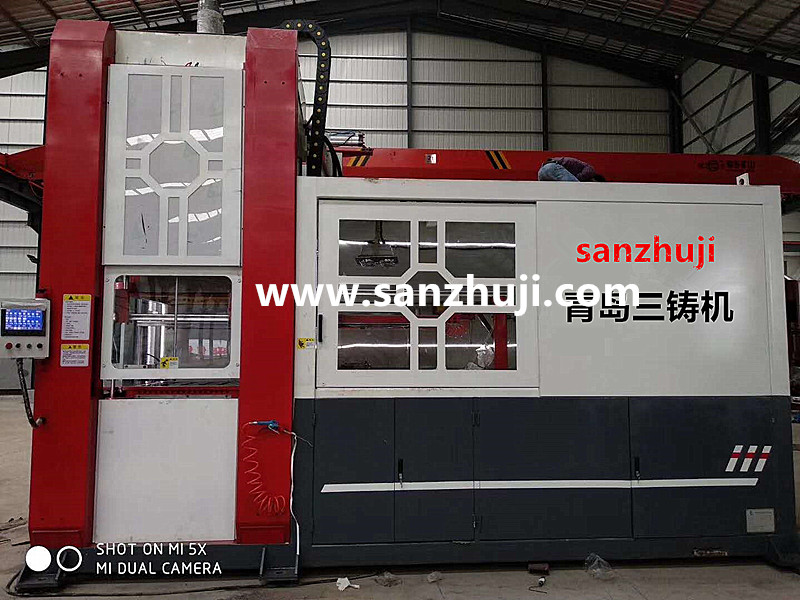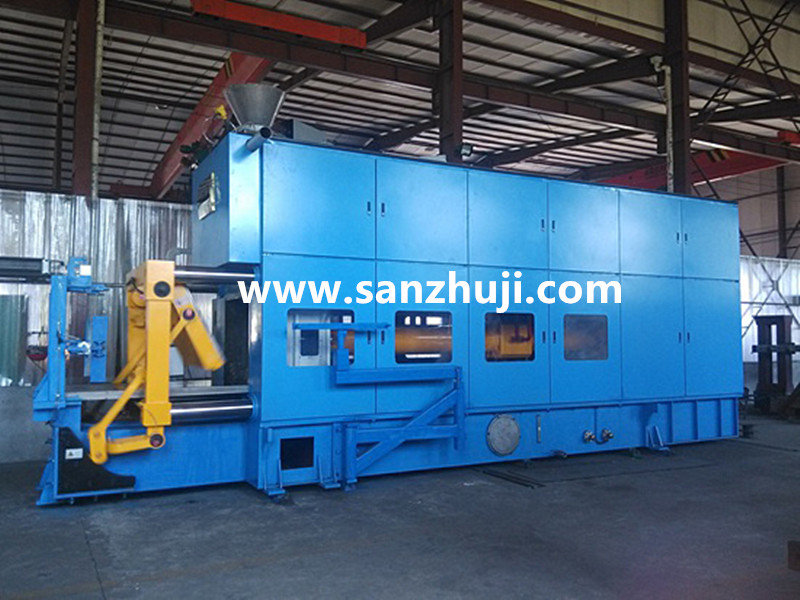1. Casting process
The casting production process is mainly divided into two categories: sand casting and special casting. Sand casting process includes: clay sand wet molding process, resin self-hardening sand molding process, water glass self-hardening sand molding process, etc. Special casting processes include: centrifugal casting, investment casting (precision casting), die casting (high pressure casting), low pressure casting, metal mold casting (including metal mold re-sand), lost foam casting, V method casting, continuous casting, squeeze casting, Differential pressure casting, graphite casting, ceramic casting. Gypsum casting, etc. Among them, lost foam casting and V method casting are often referred to as "special sand casting processes" because of the processes of sand treatment and old sand reuse. The above-mentioned different casting processes are constituted by a plurality of different production processes. Among them metal smelting, furnace pre-treatment, pouring, cleaning and post-processing
It is a common process common to various casting processes in both categories. The production of air pollutants in the main process of foundry production.
2. Pollutant analysis in the pouring section and the cooling section in the mold The characteristics of the waste gas in the pouring and cooling section: the pollution source is scattered, the composition is complex, the exhaust gas collection air volume is large, the concentration is low, and the treatment process is difficult compared to other processes.
2.1 Pouring process The casting temperature is high, that is, a large amount of high-temperature dust is generated, and organic pollutants will be generated in the casting mold.
2.11 Sand mold: Since the sand mold needs to be added with pulverized coal (clay sand) or organic binder in the preparation process, the pyrolysis of pulverized coal or organic binder will produce benzene, toluene, xylene, phenol, formaldehyde and acetaldehyde under high temperature conditions. VOCs pollutants such as polycyclic aromatic hydrocarbons.
2.12 Investment mold: Since the investment mold is subjected to high temperature roasting before casting and use, the emission of VOCs is relatively small.
2.13 Lost foam: Polystyrene or copolymer foam will decompose and generate a large amount of organic waste gas when heated during the pouring process. The main harmful components are VOCs such as benzene, toluene, ethylbenzene, and styrene, and the discharge point is the gate.
2.14 Metal mold (mostly non-ferrous alloy die casting, low pressure casting and gravity casting): The mold release agent in the mold cavity contains coatings such as silicon oxide compounds, beeswax, engine oil, graphite, high-pressure polyethylene, kerosene, etc. CO, CO2, VOCs, ethylene and other pollutants will be formed under the atmosphere.
2.2 After the casting in the cooling section of the mold, the temperature of the casting is cooled over time, the binder in the molding sand and the high-temperature oxides at the pouring riser continue to emit, and continue to cool to room temperature. The pollutant composition is basically the same as the pouring process. Carbonized soot can be produced, which is highly polluting.
3. Processing technology recommended by Sanzhuji
3.1 Collection method The pouring section is divided into dumping and bottom pouring according to the lifting method, and can be divided into mechanical pouring and manual pouring according to the operation. The commonly used collection methods cited in this article are divided into two types: fixed side absorption collection method and mobile type The collection method and subsequent configuration are all closed cooling lines.
3.11 Bag type dust collector, when the dust-laden gas enters the dust collector, the coarse dust falls into the ash hopper due to the collision of the deflector and the reduction of the gas velocity; the rest of the fine particle dust enters the filter bag room with the gas; Due to the inertia, diffusion barrier, hooking, and static electricity of the filter material fibers and fabrics, the dust is retained in the filter bag, and the purified gas escapes from the bag and is discharged through the exhaust pipe. The ash on the filter bag is removed by the gas backwashing method or the method of spraying pulsed airflow, and the removed dust is discharged by the ash discharge device. The cleaning method of bag filter has become more and more mature, and the current research mainly focuses on the filter material. The performance and quality of the filter material are directly related to the performance and service life of the bag filter. The filter material has been developed from natural fibers to synthetic fibers, which greatly improves the dust removal performance and application range of the bag filter. At present, the research of filter media mainly focuses on the development of surface-coated filter media. Surface-coated technology has brought revolutionary changes to the dust removal performance of filter media. Emission concentration: (10 ~ 30) mg/(N*m³); treatment efficiency: 98% ~ 99.9% (there are many types of bag types, and the dust removal efficiency is different).
3.12 Wet dust collectors mainly rely on inertial collision, adhesion and diffusion to remove dust. When the gas containing suspended dust particles meets the water and the gas hits the wet wall, the dust particles are adhered to the wall, or when the gas meets the sprayed droplets, the liquid agglomerates on the dust particles, increasing the Increase the mass of the particle, and make it fall. This method can eliminate SO2 gaseous pollutants at the same time, but it needs to be equipped with sewage and sludge treatment facilities. Emission concentration: (30 ~ 80)mg/(N*m³); Treatment efficiency: 90% ~ 95%.
3.2 VOCs treatment, in order to ensure the quality and stability of castings, some organic materials such as reinforcing agents (resins, curing agents) are often added to the molding sand, and VOCs are emitted during the heating process. The cast-in-place section and cooling section are commonly used. Liquid absorption method and activated carbon adsorption method.
3.2.1 Liquid absorption method, through the contact between the absorbent and the organic waste gas, the harmful molecules in the organic waste gas are transferred to the absorbent, so as to achieve the purpose of separating the organic waste gas. This treatment method is a typical physical and chemical action process. After the organic waste gas is transferred to the absorbent,The harmful molecules in the absorbent are removed by the analytical method, and then recycled to realize the repeated use and utilization of the absorbent. Emission concentration: (30~100)mg/(N*m³); treatment efficiency: 60%~90%.
3.2.2 Activated carbon adsorption method, using honeycomb activated carbon as adsorbent, combined with the principle of adsorption purification, desorption regeneration and concentration of VOC and catalytic combustion, that is, the organic waste gas with large air volume and low concentration is adsorbed by honeycomb activated carbon to purify the air. The purpose is to regenerate the activated carbon when the activated carbon is saturated with adsorption and then desorb with hot air. The desorbed and concentrated organic matter is sent to the catalytic combustion bed for catalytic combustion. The organic matter is oxidized into harmless CO2 and H20, and the hot exhaust gas after combustion The cold air is heated by the heat exchanger, and the gas cooled after the heat exchange is partially discharged, and part of it is used for the desorption and regeneration of the honeycomb activated carbon, so as to achieve the purpose of waste heat utilization and energy saving. The whole device consists of pre-filter, adsorption bed, catalytic combustion bed, flame retardant, related fans, valves, etc.to make. Emission concentration: (10~60)mg/(N*m³); treatment efficiency: 90%~99%.
4. Push the series process. According to the production process, the soot collection equipment in the casting section and the cooling section in the mold needs to be used at the same time. Due to the process requirements, the casting section can use a slit type or louver type side suction hood. The generation point (at the riser) concentrates the air volume to collect the smoke and dust, so the pouring collects The characteristics of the system are high negative pressure and low air volume; the cooling section in the mold has a large area, the sand box stays for a long time, and the smoke and dust are slowly emitted. The air pressure and air volume characteristics of the two collection systems are inconsistent, and the pipeline layout and fan selection cannot be universal. In order to ensure the collection effect, a separate exhaust gas treatment system is set up. Now, according to an engineering example, a push series collection method is introduced. The composition of flue gas pollutants collected in the pouring section and the cooling section are similar, but the characteristics of the collection system are inconsistent. The relay push fan is used to meet the flue gas collection requirements of high negative pressure and low air volume in the pouring section; the air flow after passing through the relay fan is evenly distributed. Air system, the pouring and collecting air volume is evenly distributed to the cooling line through the air inlets on both sides of the closed cooling line near the ground, and the large air volume suction vents are evenly distributed at the top of the cooling line to discharge the smoke and dust treatment system, to meet the requirements of low air pressure and large air volume. Gather requirements. The characteristic is that the exhaust air volume of the cooling line is greater than the sum of the cooling air intake volume and the dust emission rate, which ensures the low negative pressure operation of the cooling line. The air volume of the fan ensures that the closed cooling line is in a state of slight negative pressure to ensure the collection effect. In this project, due to the viscosity of the collected flue gas, the resistance of the filter bag continued to increase, and the effect of backflushing regeneration was not obvious. A pretreatment stage was set up to adsorb and wrap the viscous dust in the flue gas to ensure collection. The good separation between the particles in the smoke and the filter bag, through the coating of the pretreatment device, ensures that the resistance of the entire system is within the design range, ensures the stable operation of the system, and reduces the fan energy consumption.
Qingdao Sanzhuji Equipment Manufacturing Co., Ltd. specializes in the production of Green Sand Molding Line,Self-hardening sand molding line,foundry machines,Sand molding machine,Sand casting equipment,sand mixer,GS high efficiency rotary mixer,Resin sand mixer,no-bake resin sand mixer,Jolt squeeze molding machine/Jolt-squeezing moulding machines,Multi- Piston Moulding Machine/Hydraulic multi-piston moulding machine,sand casting molding machine,sand reclamation equipment,foundry molding machine,flaskless moulding machine,shot blasting machine,dust collector,according to the amount of old sand recovered Carry out plan customization, and provide sand reclamation equipment installation, commissioning, and training. Welcome guests to visit the factory.








